Decomposed granite (DG) is a great choice for decorating patios and creating pathways, seating areas, and the like.
It is a rock that has been weather-beaten and can easily fragment into smaller fragments of weak rocks. It is often 3/8 inch or smaller in size.
This granite has a wide variety of applications that makes it popular in places like the Southwestern regions of the United States.
Even though it is a popularly adopted hardscaping material, it has a number of disadvantages, which is what this article is about. Read on to find out the most common disadvantages of decomposed granite.
Types of Decomposed Granite
The three major types of DG are outlined below.
Related: Best Gravels to Walk on Bare Feet
Natural Loose DG
This is a naturally occurring DG that is not mixed with any additive. It is usually installed and compacted using a Vibraplate.
This enables the particles to fuse together and stay in place. They’re often used for seating areas, parks, and pathways with less traffic.
This is the least expensive type that’s often used by most people with a low budget. It gives a garden path a nice look and attractive appearance.
Stabilized DG
Stabilized DG is mixed with stabilizing agents that help to bind the particles together and keep them in place.
The particles become packed together and have a tough and hard appearance. This helps to reduce erosion and some other problems associated with the use of DG.
Even with the use of stabilizers, keep in mind that the major problems of erosion and damage caused by debris are not completely eliminated; they’re only reduced.
DG with Resin
This is the most expensive type and the most preferred for high-traffic areas. It involves mixing DG with resin to bind the particles together turning them into an asphalt-like material.
The surface becomes hard and the texture is altered. And the sandy appearance is eliminated.
Advantages (Pros) of Decomposed Granite
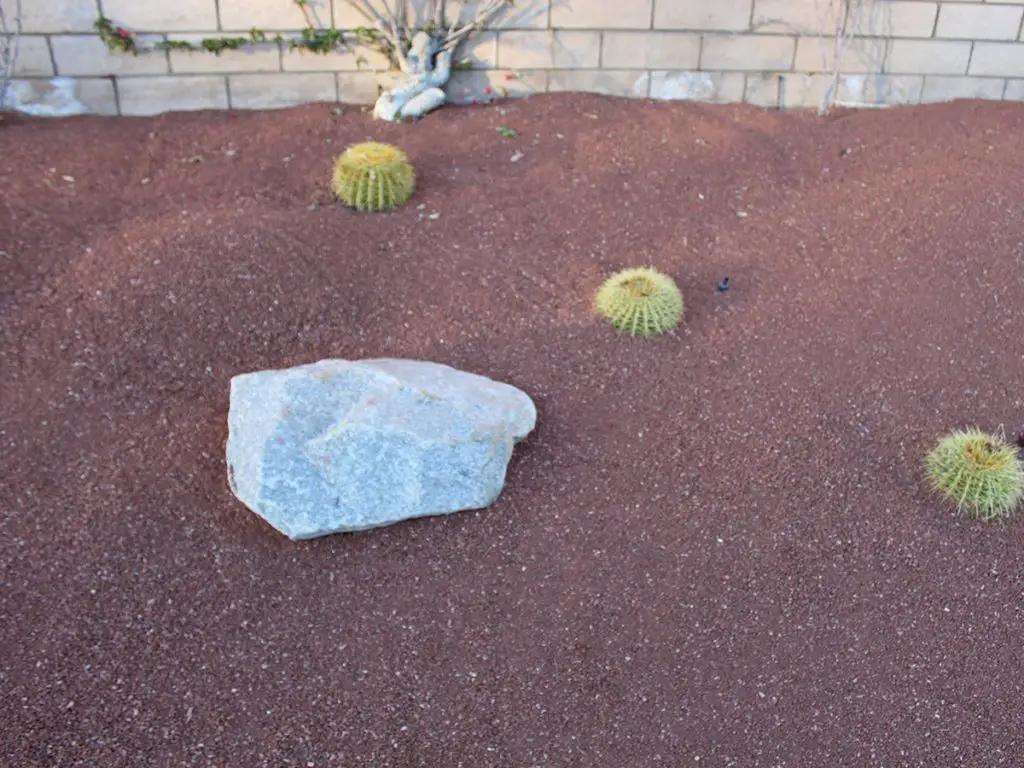
I know this article is supposed to focus on the disadvantages of DG. But I believe it doesn’t hurt to have a quick look at some of its advantages.
- It is easy to install
- It is available in a variety of colors
- DG is a good choice for xeriscaping
- It gives a natural appearance
- Loose DG is inexpensive
Related: 10 Best Wholesale Mulch Suppliers to Buy from
Disadvantages (Cons) of Decomposed Granite
The following are the major disadvantages of decomposed granite.
1. It gets muddy
Decomposed granite tends to get muddy during the winter when there is high rainfall.
DG is composed of granite fines and small pieces of granite; this combination has a high tendency of fusing together with the presence of water. This results in DG changing its form from loose to muddy.
This process doesn’t occur with gravels. It’s a problem that is specific to DG. It can, however, be reduced by the introduction of resins.
But this is quite expensive and can be a tough step when you need DG in large quantities for a large hardscaping project.
2. It has a tendency to grow weeds
Not only can it grow weeds, but it can also grow moss. Weeds and moss are a great challenge that you have to face with DG.
This will require you to frequently rake it to remove the unwanted visitors. When you use DG on your patio, you need to have in mind that it is not maintenance-free like having concrete on your walkway.
The presence of weeds and moss will alter the appearance of your environment and will keep the installed DG from looking as beautiful as you expect. You have to frequently rake it to avoid this.
This could be tiring if you have to do it alone.
3. It has a tendency to erode
Except when used with additives, DG has a very high tendency to erode.
And it tends to erode over time even when additives are used. It is made of rocks that have weathered and can easily fracture into smaller pieces.
This makes it susceptible to erosion, especially during the winter when the rainfall is high.
Erosion causes a reduction in quantity and changes the appearance of your walkway, patio, or environment in general.
This can happen in a short while or over time, depending on the type of DG in question. Natural DG without additives erodes quickly while DG with additives takes more time to erode.
4. It is more suitable in certain environments
DG is preferable and more suitable for use in areas with less rainfall. This is obviously due to its nature.
The particles have a tendency to become muddy and erode over time as a result of frequent rainfall.
Although DG is permeable and allows water to percolate and seep through to the ground, it retains water, which also has an effect on its features.
The retained water makes it muddy and messy. As a result, the environment may become uncomfortable and inconvenient for easy movement on foot.

5. It requires frequent refilling
You may need to refill your patio or walkway from time to time when you use DG. This is a result of possible erosions that may occur over time.
The problem of erosion is even more challenging when you have to refill with the same color of DG.
Getting the exact match is sometimes very difficult. It could be out of stock and may not be available for a long time due to several reasons.
One way of overcoming this is to prepare beforehand. Get some of the original available and have them around as a backup.
Related: 10 Best Mulches for Wet Areas
6. Debris may damage floors
This is a common occurrence, especially when you place DG near the entrance of your home.
The granite can be tracked in by anyone or even your pet. This can cause damage if you have hardwood flooring.
You may have to install a floor mat to avoid this damage. In this case, the debris will be trapped in the mat and you’ll have to sweep it off regularly.
This means more work in terms of maintenance in order to keep the environment clean.
7. DG with resin is expensive
Most of the disadvantages of DG can be minimized by mixing it with natural resin. But this is another problem on its own; it’s expensive.
Another problem associated with mixing DG with resin is that it becomes asphalt-like material.
The end result is more asphalt-like than DG-like, and this may become less desirable for the original purpose it’s needed for.
Where to Use DG
DG is a versatile material that has several uses. It can be used in areas with low traffic and is suitable for use in areas with high traffic. Some of the major places it can be used include:
- Driveways
- Pathways
- Landscapes
- Hardscapes
- Patios and
- Roads
Related: Unique Purposes of the Sprinkler Valve Bleed Screw
Decomposed Granite: All You Need to Know
Read on if you still want to know more about DG. You’ll learn as much as possible about it.
Decomposed Granite Driveway Disaster
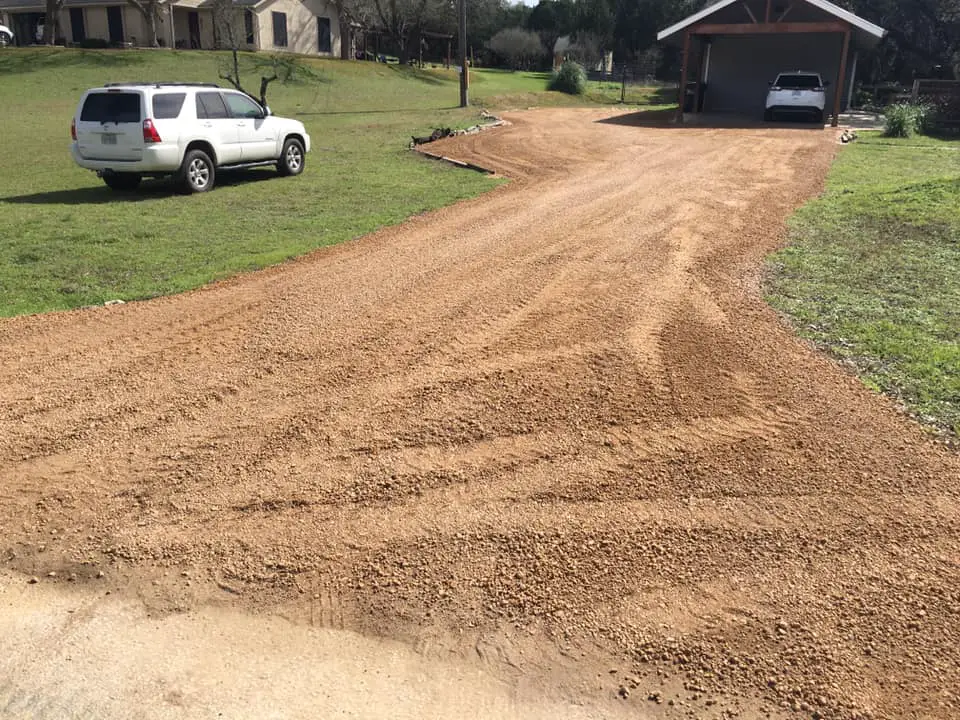
Decomposed granite can present challenges when used for driveways, especially in areas with heavy rainfall or poor drainage.
These conditions can contribute to the shifting and unevenness of the material, resulting in an unstable and bumpy surface.
Let’s delve deeper into these issues and discuss potential solutions.
Shifting and Unevenness
One of the primary concerns with DG driveways is the tendency of the material to shift.
This can occur due to water runoff, erosion, or the natural settling of the ground.
When decomposed granite moves, it creates an uneven surface that can be challenging to traverse, particularly for vehicles.
Proper installation and preparation are crucial to mitigate shifting and unevenness.
Before laying decomposed granite for a driveway, it’s important to excavate the area and ensure a stable base.
This typically involves removing the topsoil and compacting the subgrade to create a firm foundation.
Adding a layer of geotextile fabric between the subgrade and decomposed granite can further aid in stabilization by preventing the intermixing of materials.
Drainage Issues
Another factor that can contribute to a decomposed granite driveway disaster is poor drainage.
If the driveway doesn’t have an adequate slope or if the surrounding landscape lacks proper drainage systems, water can accumulate and seep into the surface of the DG.
This can lead to erosion, which washes away the fine particles and causes the driveway to become uneven and prone to potholes.
To address drainage issues, it’s essential to evaluate the slope of the driveway and ensure that water flows away from the surface.
Proper grading and the installation of drainage channels or French drains can help redirect water and prevent it from pooling on the driveway.
Incorporating a border or edging material along the sides of the driveway can also help contain the decomposed granite and prevent it from spreading or eroding.
Related: Hemlock vs Fir Mulch: A Comprehensive Comparison
Crushed Granite Walkway Pros and Cons

Crushed granite walkways can be a visually appealing addition to your landscape, providing a rustic and natural charm.
However, it’s essential to consider both the advantages and disadvantages before opting for this material.
Pros
- Permeability
The porous nature of the material allows rainwater to penetrate through the surface, which reduces runoff and promotes better absorption into the soil.
This can help mitigate issues related to water accumulation and drainage, preventing the formation of puddles or erosion on the walkway.
- Low Maintenance
Unlike traditional concrete or paved walkways, they generally don’t require sealing or regular upkeep.
The natural composition of crushed granite allows it to withstand weather conditions, such as freezing and thawing, without significant deterioration.
Routine maintenance typically involves removing debris and occasional leveling to ensure a smooth walking surface.
Cons
- Potential Weed Growth
Over time, weed seeds can find their way into the crevices and gaps between the crushed granite particles.
If left unattended, weeds can detract from the overall appearance of the walkway and create additional maintenance tasks.
To address weed growth, it’s essential to take preventative measures during installation.
A layer of geotextile fabric placed beneath the crushed granite can act as a weed barrier while still allowing water to permeate.
Regularly inspecting the walkway and manually removing any emerging weeds can help maintain its aesthetic appeal.
- Uneven Surfaces
The particles can shift and settle over time, resulting in an irregular walking surface. This may be more noticeable in high-traffic areas or where water runoff occurs.
Proper installation and maintenance techniques often help to minimize unevenness.
Excavating the area and creating a compacted base before applying the crushed granite can help ensure a more stable surface.
Periodically raking and leveling the walkway can help redistribute the crushed granite and reduce the occurrence of uneven spot
Related: Best Mulches for Citrus Trees in Pots
Crushed Granite Driveway Pros and Cons
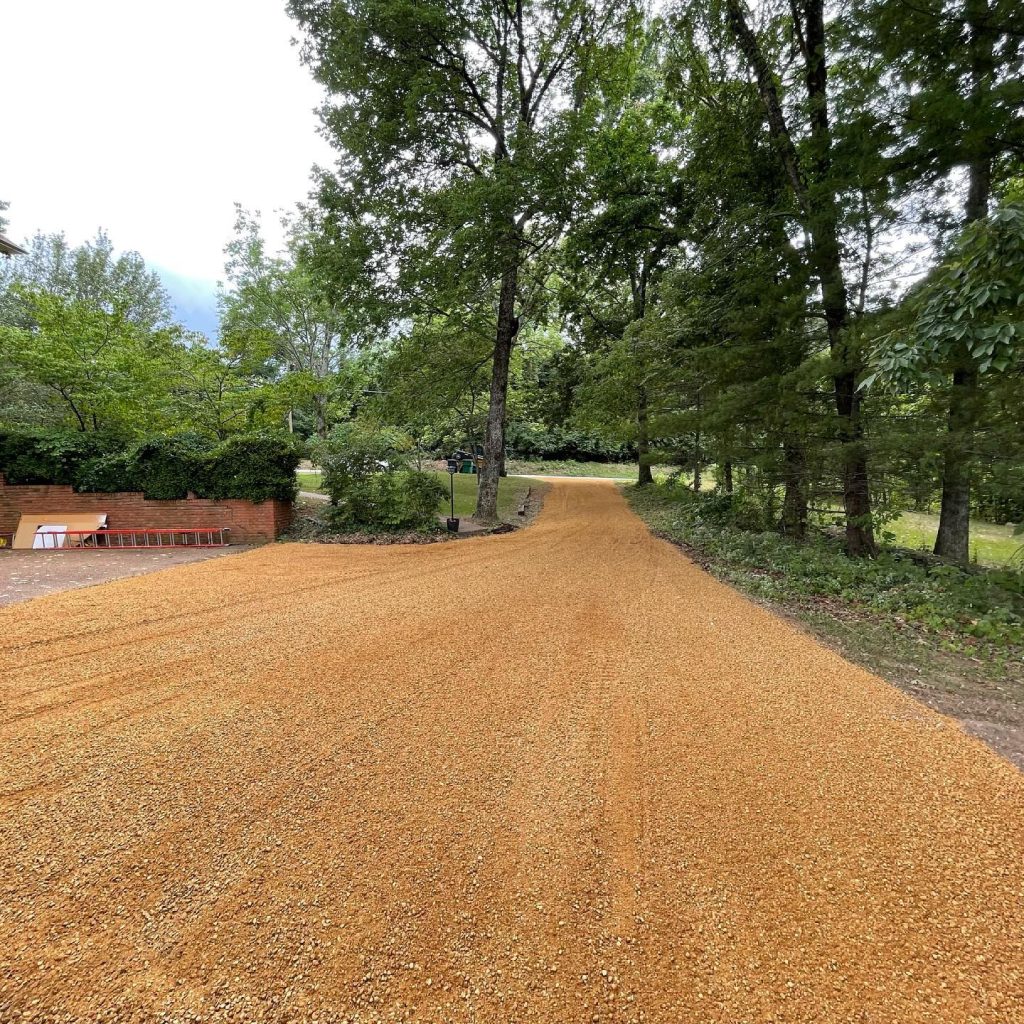
A crushed granite driveway can offer several benefits. But it also has some drawbacks.
Pros
- Cost-Effectiveness
Crushed granite is typically more affordable compared to other driveway materials such as concrete or pavers.
It allows homeowners to achieve a visually appealing driveway without breaking the bank. If you’re working within a budget, crushed granite can be an attractive option.
- Eco-Friendliness
It’s a natural material that’s mined and processed with minimal energy consumption.
By using crushed granite, you reduce the need for synthetic or manufactured materials.
Its permeability also allows rainwater to infiltrate the ground, minimizing water runoff and contributing to better water management on your property.
Cons
- Durability Issues
While crushed granite can withstand normal vehicle traffic, it may not be as durable as materials like concrete or asphalt.
Heavy vehicles or excessive use can cause the surface to shift or become compacted, resulting in an uneven and potentially less stable driveway.
If you anticipate heavy use or have large vehicles, you may need to consider alternative materials for better longevity.
Related: How Much Brushtox per Gallon of Water? (Answered)
How to Harden Decomposed Granite
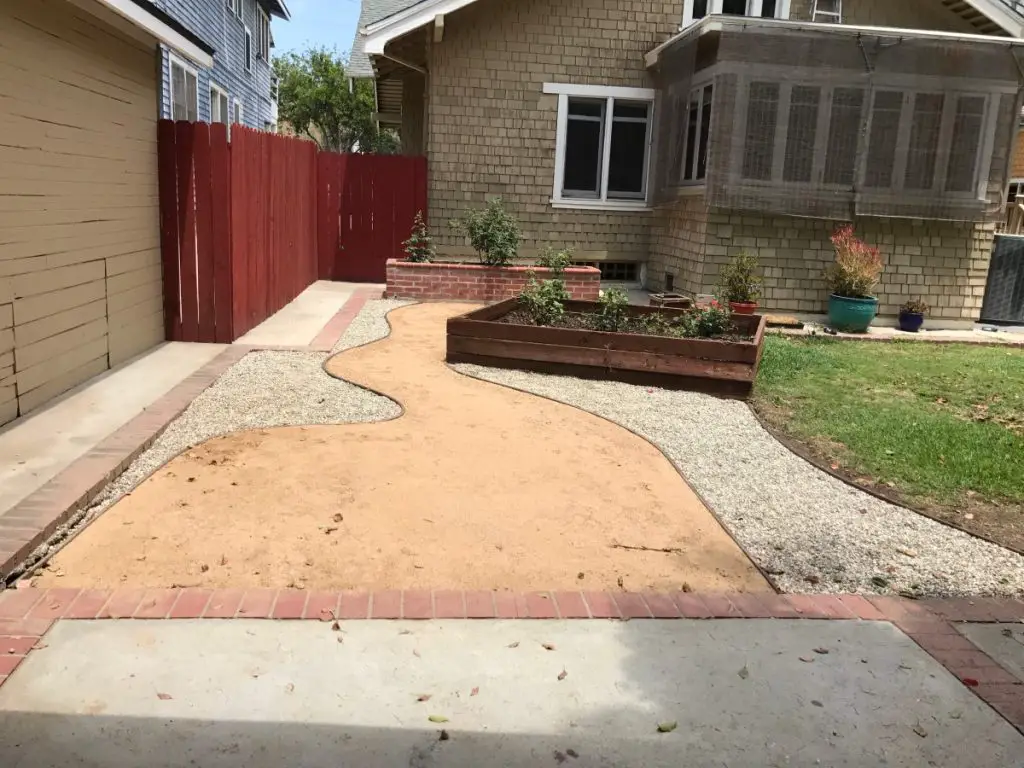
Hardening decomposed granite is an important step to enhance its stability and mitigate issues such as shifting or erosion.
By implementing effective techniques, you can create a firmer and longer-lasting surface. Below are some practical tips for hardening DG.
Stabilizers
Stabilizers are additives that can be mixed with decomposed granite to improve its cohesion and stability.
These products often come in liquid or powder form and work by binding the particles together.
Stabilizers help reduce the movement of decomposed granite and enhance its load-bearing capacity.
When using these additives, follow the manufacturer’s instructions regarding the appropriate application rate and mixing process.
It typically involves mixing the stabilizer with the decomposed granite thoroughly, ensuring even distribution.
Afterward, compact the mixture using a plate compactor or roller to achieve maximum density.
Binding Agents
Another way to harden decomposed granite is by incorporating binding agents into the material.
Binding agents, such as various types of resins or organic materials, create a stronger bond between the granite particles, reducing movement and enhancing stability.
The selection and application process for binding agents may vary depending on the specific product.
Some binding agents require mixing with water or other additives, while others come pre-mixed and ready to use.
It’s important to follow the manufacturer’s instructions carefully to ensure proper application.
Moisture Control
Controlling moisture levels is important when hardening decomposed granite.
Excessive moisture can cause the material to become loose and unstable, while insufficient moisture can hinder the binding process.
Aim for a moisture content that allows for optimal compaction and binding.
Before applying stabilizers or binding agents, ensure that the decomposed granite is slightly damp but not overly saturated.
Lightly moistening the material can help facilitate the binding process and improve compaction results.
However, avoid excessive watering or working with decomposed granite during heavy rainfall, as it may compromise the hardening process.
Compaction
Proper compaction is essential to achieve a hardened decomposed granite surface. Use a plate compactor or roller to compact the material thoroughly.
This process helps eliminate air gaps, increases density, and enhances stability.
Start compacting from one end of the area and work your way toward the other end in overlapping passes.
Pay attention to any low spots or uneven areas and make additional passes as necessary. Proper compaction ensures a more solid and stable DG surface.
Related: Pros and Cons of Gorilla Hair Mulch
How to Clean Decomposed Granite
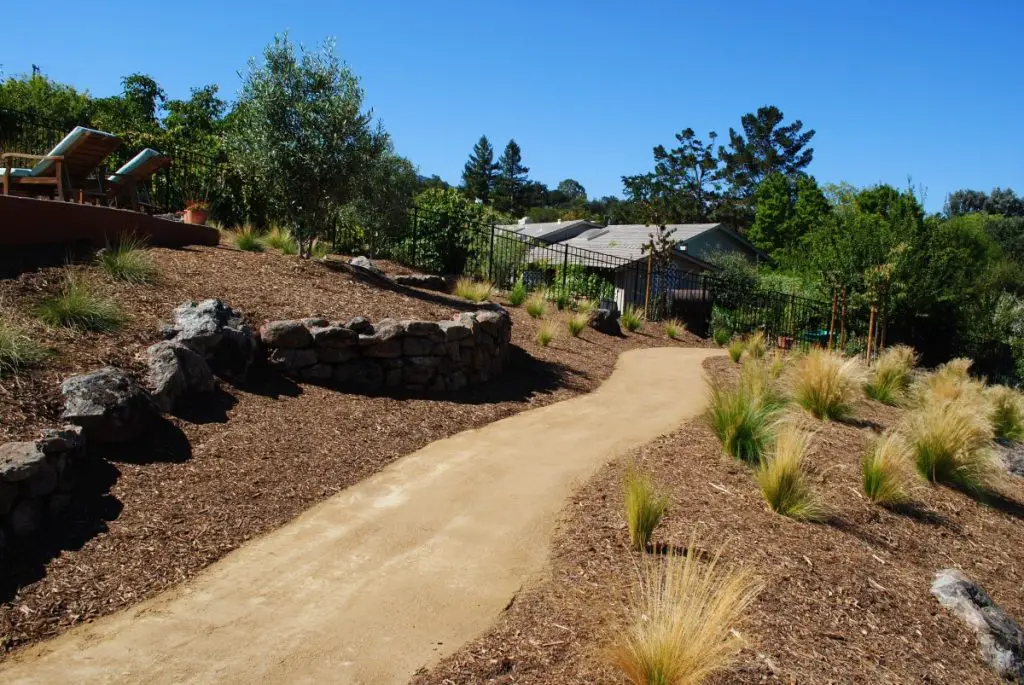
Keeping decomposed granite clean helps to preserve its appearance and longevity.
Regular cleaning prevents the buildup of debris, dirt, and organic matter that can contribute to discoloration or deterioration.
Here are effective methods for cleaning DG.
Sweeping
Sweeping the surface regularly with a stiff-bristle broom or a leaf blower is a simple yet effective way to remove loose debris and leaves.
Start from one end of the area and work your way toward the other, ensuring that you cover the entire surface.
Focus on areas where debris tends to accumulate, such as corners or near vegetation.
Rinsing with Water
Occasionally rinsing the decomposed granite with water can help remove stubborn dirt or stains.
Use a garden hose or a pressure washer in a gentle setting to avoid damaging the surface. Direct the water flow evenly across the entire area, ensuring that it reaches all sections.
Be mindful of any adjacent plants or areas where runoff can cause erosion or pooling.
Weed Prevention
Regularly inspect the surface for any emerging weeds and manually remove them before they take root.
Applying a pre-emergent weed control product can help prevent weed seeds from germinating, reducing the need for constant weeding.
However, be cautious when selecting and applying weed control products, as some may be harmful to surrounding plants or the environment.
Removing Stains
If you encounter stains on the decomposed granite, prompt action can help minimize their impact.
For oil or grease stains, sprinkle an absorbent material such as baking soda or kitty litter on the affected area to absorb the oil.
Allow it to sit for a few hours or overnight, then sweep or vacuum it up.
You can also create a paste by mixing baking soda with water and applying it to the stain, letting it sit for a while before rinsing it off.
For other types of stains, mild dish soap diluted in water can be effective.
Gently scrub the stained area with a soft brush or sponge, then rinse thoroughly with water.
Avoid using harsh chemicals or abrasive cleaners, as they can damage the decomposed granite.
Related: How to Move Large Rocks with a Tractor
Installing Decomposed Granite: 6 Steps to Follow
Installing decomposed granite requires careful preparation and execution to ensure a successful and long-lasting project.
Follow these step-by-step instructions for proper installation.

1. Prepare the Area
- Clear the area
Remove any existing vegetation, rocks, or debris from the site. Trim overhanging branches or vegetation that may interfere with the installation process.
- Excavate the site
Dig out the area to create a suitable base for the decomposed granite. Use a shovel, rake, or grading equipment to ensure an even surface.
2. Install Edging
Edging helps contain the DG and prevent migration.
Choose a suitable edging material such as plastic or metal landscape edging, concrete curbing, or natural stone.
Install the edging around the perimeter of the excavated area, securing it firmly into the ground.
Ensure that the edging sits slightly above the desired level of the finished decomposed granite surface.
3. Add a Weed Barrier
Consider adding a weed barrier or geotextile fabric beneath the decomposed granite to prevent weed growth.
This permeable material allows water to pass through but prevents weed seeds from germinating.
Unroll the weed barrier over the excavated area, trimming it to fit within the edging. Overlap the edges of the fabric by a few inches to ensure complete coverage.
4. Lay the Decomposed Granite
Spread the decomposed granite evenly over the prepared area. Use a shovel or a landscape rake to distribute the material and create a uniform layer.
Aim for a thickness of about 2 to 3 inches for pedestrian areas and 3 to 4 inches for driveways or areas with heavier traffic.
Adjust the depth according to your specific project requirements.
5. Compact the Decomposed Granite
Use a plate compactor or roller specifically designed for compacting granular materials.
Start from one end of the area and work your way toward the other, making multiple passes with the compactor.
Ensure even compaction across the entire surface, paying extra attention to high-traffic areas.
6. Finishing Touches
After compacting, visually inspect the decomposed granite surface for any low spots or uneven areas.
Add additional material as needed and re-compact those areas to achieve a level surface.
Use a landscape rake or broom to sweep any excess DG off the surface and into the gaps between the particles.
This helps create a more cohesive and visually appealing finish.
Related: How Long Does It Take to Move a Ton of Gravel? (Answered)
How to Compact Decomposed Granite
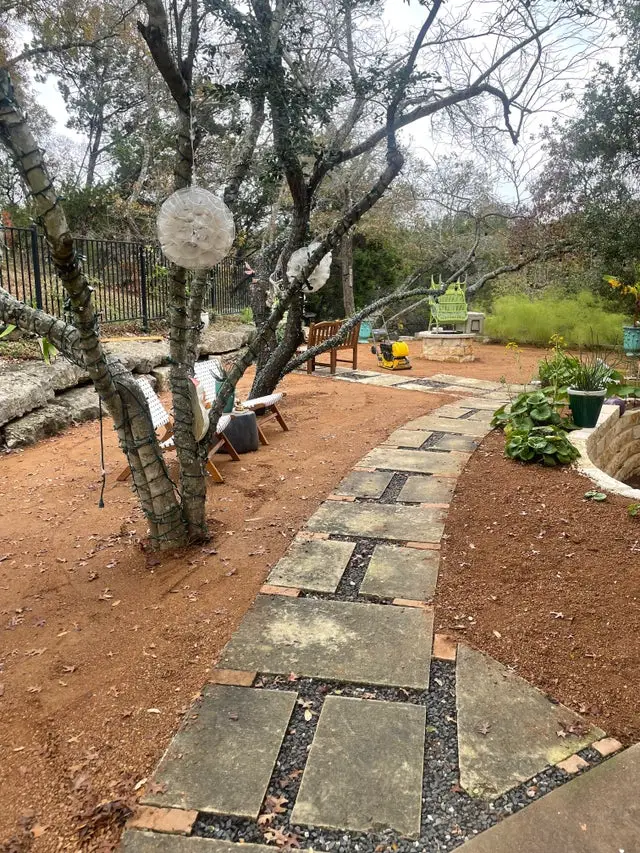
Compacting decomposed granite helps to ensure its stability and longevity.
Proper compaction creates a firm and durable surface that resists shifting, settling, and erosion.
Here’s a guide on how to effectively compact decomposed granite.
Understand the Importance of Compaction
Compaction is good for several reasons.
- It increases the density of the decomposed granite, improving its load-bearing capacity and resistance to movement
- Compacted decomposed granite minimizes the formation of voids and air pockets, reducing the risk of settling or shifting over time
- Compaction enhances the interlocking of the granite particles, promoting a more stable and cohesive surface
Equipment for Compaction
To achieve effective compaction, you’ll need suitable equipment, such as…
- Plate compactor
A plate compactor is a machine with a flat, heavy plate that vibrates and exerts downward force.
It’s commonly used for compacting granular materials like decomposed granite.
Select a plate compactor with the appropriate weight and size for your project.
- Roller compactor
A roller compactor consists of one or more smooth or padded drums that apply pressure and compaction through rolling.
It’s more suitable for larger areas or when working with thicker layers of decomposed granite.
Preparation
Before compacting the decomposed granite, ensure that the surface is properly prepared.
- Clear the area of debris, rocks, or vegetation that may hinder the compaction process
- Spread the decomposed granite evenly over the area, aiming for the desired thickness
- Rake or spread the material to create a uniform layer, avoiding any significant variations in depth
Start Compacting
Follow these steps to compact the decomposed granite effectively.
- Begin compaction from one end of the area and work your way toward the other, maintaining a systematic approach
- Position the plate compactor or roller compactor at the starting point
- Turn on the machine and slowly move it forward, allowing the plate or drum to make contact with the decomposed granite
- Apply steady and even pressure as you move the compactor across the surface. Overlap each pass to ensure complete compaction
- Repeat the process, making multiple passes over the entire area. The number of passes may vary depending on the thickness of the decomposed granite and the desired level of compaction
Adjustments and Checking for Proper Compaction
During the compaction process, visually inspect the DG surface for any signs of low spots or uneven areas.
If you notice any, add additional material and repeat the compaction process in those areas to achieve a level surface.
To check for proper compaction, walk on the surface after compaction. It should feel solid and stable underfoot.
If there are areas that feel soft or exhibit excessive movement, it may indicate insufficient compaction, and those areas should be re-compacted.
Remember that the compaction process may need to be repeated periodically, especially for high-traffic areas or if the decomposed granite becomes loose or settles over time.
Related: Best Equipment to Move Large Rocks
Decomposed Granite vs. Sand

Decomposed granite and sand are both commonly used materials with distinct characteristics and applications.
Understanding the differences between them can help you determine the more suitable option for your specific project.
Let’s compare both based on various factors.
Stability
- Decomposed Granite
Decomposed granite is generally more stable than sand due to its composition.
It consists of crushed granite particles that interlock and create a cohesive surface when properly compacted.
This interlocking nature provides better stability and resistance to movement or erosion.
- Sand
Sand is not as stable as decomposed granite. Its loose and granular nature allows for more movement and shifting.
Sand tends to shift and settle over time, especially when subjected to heavy foot traffic or rainfall.
Additional measures like compaction or binding agents may be necessary to enhance stability when using sand.
Drainage
- Decomposed Granite
Decomposed granite offers good drainage due to its permeable nature.
Rainwater can easily pass through the small gaps between the granite particles, reducing the risk of standing water and potential drainage issues.
This makes decomposed granite suitable for areas where proper drainage is essential.
- Sand
Sand also provides good drainage capabilities. Its granular structure allows water to flow through and percolate into the underlying layers.
Sand is often used in applications where drainage is a primary concern, such as for sports fields, golf course bunkers, or areas prone to water accumulation.
Versatility
- Decomposed Granite
Decomposed granite is a versatile material with various applications. It can be used for pathways, patios, and driveways, and as a base material for pavers or flagstones.
Its natural appearance and range of color options make it suitable for both formal and informal landscapes.
It can also be mixed with other materials like stabilizers or binding agents to enhance its characteristics.
- Sand
Sand is also versatile and finds applications in a wide range of projects.
It’s commonly used in concrete and mortar mixes, as a leveling base for pavers or tiles, and in children’s sandboxes.
Sand is available in different grades, such as fine, medium, or coarse, allowing for flexibility in selecting the appropriate type for specific uses.
Maintenance
- Decomposed Granite
Decomposed granite generally requires minimal maintenance.
Regular sweeping or blowing to remove debris and occasional re-compaction is usually sufficient to keep the surface in good condition.
However, it may need occasional replenishment or re-leveling over time, particularly in high-traffic areas.
- Sand
Sand may require more maintenance compared to decomposed granite. It’s prone to shifting and displacement, especially in areas with heavy foot traffic or wind.
Regular leveling, sweeping, and brushing to redistribute the sand may be necessary to maintain an even surface.
It can also be prone to weed growth, requiring periodic weeding or the use of weed control measures.
Related: What You Need to Know about Mexican Landscapers/Yard Workers
Planting in Decomposed Granite

Planting directly in decomposed granite can present both benefits and challenges.
Here are some insights to consider for successful plant growth in DG.
Soil Preparation
Before planting in decomposed granite, it’s essential to improve the soil conditions by incorporating organic matter.
This helps enrich the soil and enhance its nutrient-holding capacity.
Add compost or well-rotted manure to the decomposed granite and mix it thoroughly. This will improve the soil structure, water retention, and nutrient availability for the plants
Consider testing the pH level of the DG. Some plants may require adjustments to the pH level for optimal growth.
Consult a local gardening center or conduct a soil test to determine the appropriate amendments.
Plant Selection
Choose plants that are well-suited to the conditions of decomposed granite, such as those tolerant of well-drained soil and drier conditions.
Look for plants that have adapted to sandy or rocky environments, as they’re more likely to thrive in decomposed granite.
Native plants or drought-tolerant species are often good choices.
Consider plants with deep root systems that can penetrate the DG and access moisture and nutrients from deeper layers of soil.
Pay attention to the sunlight exposure and microclimate of the planting area, as this will influence plant selection.
Some plants may prefer full sun, while others may thrive in partial shade.
Watering and Maintenance
Decomposed granite offers good water permeability and drainage, but it also means that water can quickly drain away from plant roots.
Regular watering is essential, especially during dry periods, to ensure plants receive adequate moisture.
Apply a layer of mulch around the base of the plants to help retain moisture, regulate soil temperature, and suppress weed growth.
Monitor the moisture levels in the decomposed granite and adjust your watering schedule accordingly.
Avoid overwatering, as excessive moisture retention can lead to root rot or other issues.
Regularly check for weeds and remove them promptly to prevent competition for nutrients and water.
Fertilization
Regular fertilization is important since decomposed granite may not provide all the necessary nutrients for plant growth.
Apply a balanced slow-release fertilizer or organic amendments according to the specific needs of the selected plants.
Follow the manufacturer’s instructions for application rates and frequency.
Consider using fertilizers or soil amendments that promote root development and improve nutrient absorption, as the decomposed granite may not have ideal nutrient-holding capacity.
Monitoring and Adjustments
Regularly monitor the health and growth of the plants in the decomposed granite.
Look for signs of stress, such as wilting or yellowing leaves, and address any issues promptly.
Adjust your planting and maintenance practices as needed.
This may include amending the soil with additional organic matter, adjusting watering schedules, or selecting more suitable plant varieties.
Related: Ariens Vs Husqvarna Zero Turn Mowers
Decomposed Granite Alternatives
If you’re considering alternatives to decomposed granite for your landscaping project, there are several materials available that can offer similar aesthetics and functional benefits.
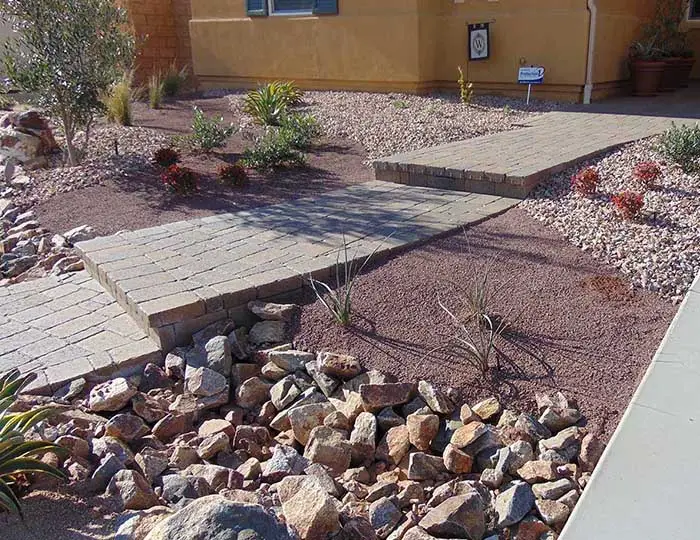
Here are some popular options to consider.
Crushed Rock or Gravel
It’s available in various sizes and colors, so you can create different textures and visual effects in your landscape.
Similar to decomposed granite, crushed rock provides good drainage and water permeability. It can be used for pathways, driveways, or as a ground cover in garden beds.
One advantage of crushed rock is its durability. It tends to be more resistant to shifting and erosion compared to decomposed granite. This makes it suitable for high-traffic areas.
Permeable Pavers
Permeable pavers are another excellent alternative to decomposed granite, especially if you’re looking for a more formal or structured appearance.
These interlocking pavers allow water to infiltrate through the gaps between them, promoting proper drainage.
Permeable pavers come in various styles, sizes, and materials such as concrete, clay, or natural stone.
They can be arranged in different patterns, providing aesthetic versatility.
Installing permeable pavers requires a proper base and sub-base preparation, ensuring stability and long-term performance.
Flagstone
Flagstone is a popular natural stone alternative that offers a unique and timeless look.
It comes in different shapes, sizes, and colors, allowing for creative and customizable designs.
Similar to decomposed granite, flagstone can be used for pathways, patios, or even as stepping stones in gardens. It provides a natural and rustic appeal.
Proper installation of flagstone involves creating a stable base, ensuring even spacing between the stones, and filling the gaps with suitable materials like sand or gravel.
Wood Chips or Mulch
This can be used as an alternative ground cover to decomposed granite, particularly in garden beds or areas with plants.
They provide a natural look and help retain moisture in the soil.
Wood chips or mulch are available in different sizes and materials, such as hardwood or bark. This offers options for both aesthetic preference and functional requirements.
It’s important to note that wood chips or mulch may require regular replenishment as they break down over time.
Artificial Turf
This is an alternative to consider if you’re looking for a low-maintenance and evergreen ground cover option.
It provides a lush and consistent appearance that requires minimal watering and upkeep.
Artificial turf can be installed on various surfaces, including pathways or smaller areas where you might have considered using decomposed granite.
The installation process for artificial turf involves proper base preparation and following the manufacturer’s guidelines for securing and maintaining the turf.
Related: Karcher Vs Ryobi Pressure Washers: Comparison
Decomposed Granite Frequently Asked Questions (FAQs)
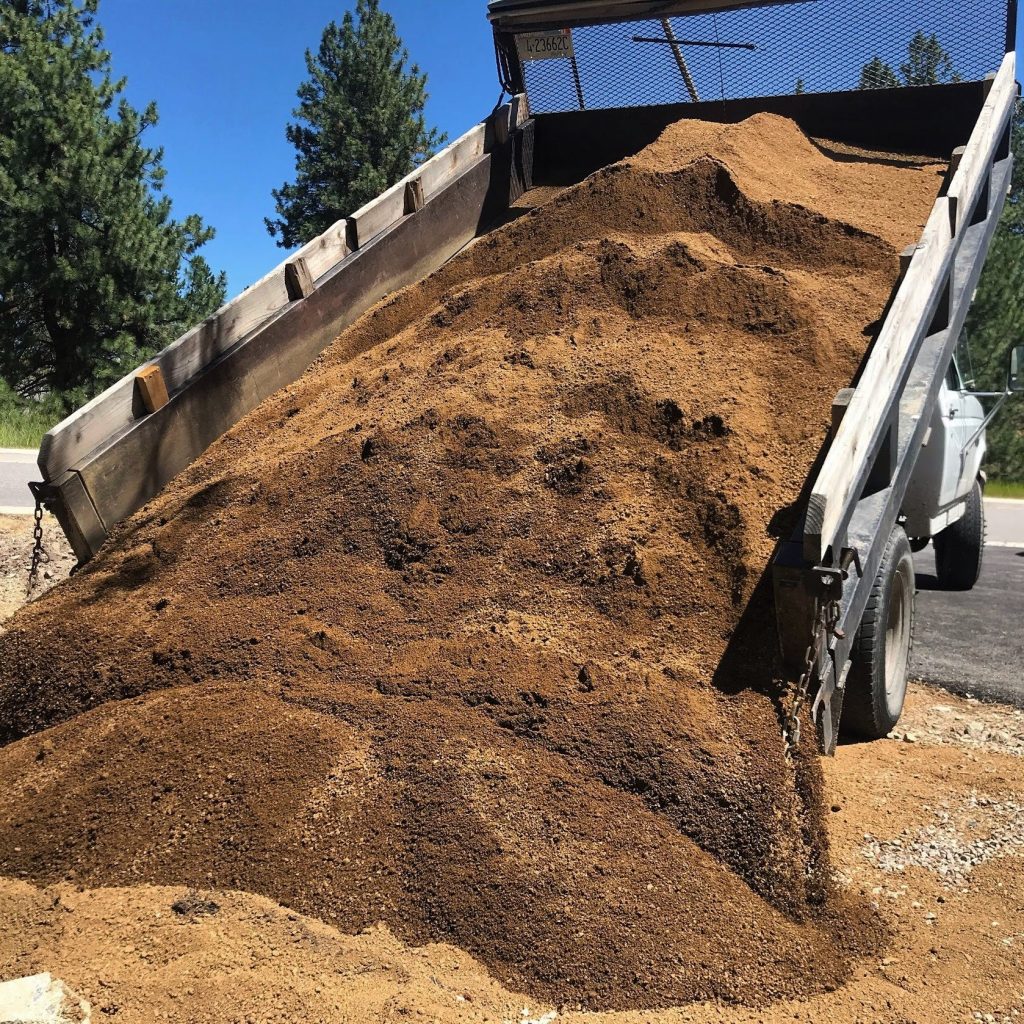
Does Decomposed Granite Get Muddy?
One common concern when using decomposed granite is whether it becomes muddy after rainfall or watering.
Unlike clay-based soils that become muddy and retain water, decomposed granite has excellent drainage properties.
When properly installed and compacted, decomposed granite allows water to percolate through the small gaps between the particles, minimizing the risk of mud formation.
However, excessive water or poor drainage conditions can still result in temporary muddiness.
It’s important to ensure proper grading and adequate drainage in your project to maintain the optimal performance of DG.
How Long Does Decomposed Granite Last?
The lifespan of decomposed granite depends on various factors such as usage, weather conditions, and maintenance.
When used for pathways, driveways, or other similar applications, decomposed granite can last for several years or even decades.
However, regular maintenance and occasional replenishment may be required to ensure its longevity.
Factors that can affect the lifespan of decomposed granite include heavy traffic, erosion, and the quality of the underlying base.
With proper installation and care, it can provide a durable and long-lasting surface.
Related: How to Use Lava Rocks for Plants
Is Decomposed Granite Permeable?
Yes, decomposed granite is highly permeable. Its loose composition allows water to pass through the small gaps between the particles, promoting good drainage.
This permeability is one of the advantages of using decomposed granite in landscaping projects.
It helps prevent standing water, reduces the risk of erosion, and allows for efficient moisture penetration to the underlying soil.
However, it’s important to note that the level of permeability may vary depending on the compaction and the size of the decomposed granite particles used.
Is Decomposed Granite Toxic?
Decomposed granite is generally considered safe and non-toxic. It’s a naturally occurring material composed of weathered granite rock.
However, it’s always advisable to use caution when handling any construction material.
Avoid inhaling dust particles by wearing a dust mask during installation or maintenance activities.
If you have concerns about specific health issues or sensitivities, it’s best to consult with a medical professional or contact your local health department for further guidance.
Check out more on Mulch
- Best Gravels to Walk on Bare Feet
- 10 Best Mulches for Wet Areas
- Top 10 Wholesale Mulch Suppliers
- Grass Mulching Pros and Cons
- Gorilla Hair Mulch Pros and Cons
- Best Mulch for Perennials
- 8 Best Mulches for Citrus Trees in Pots
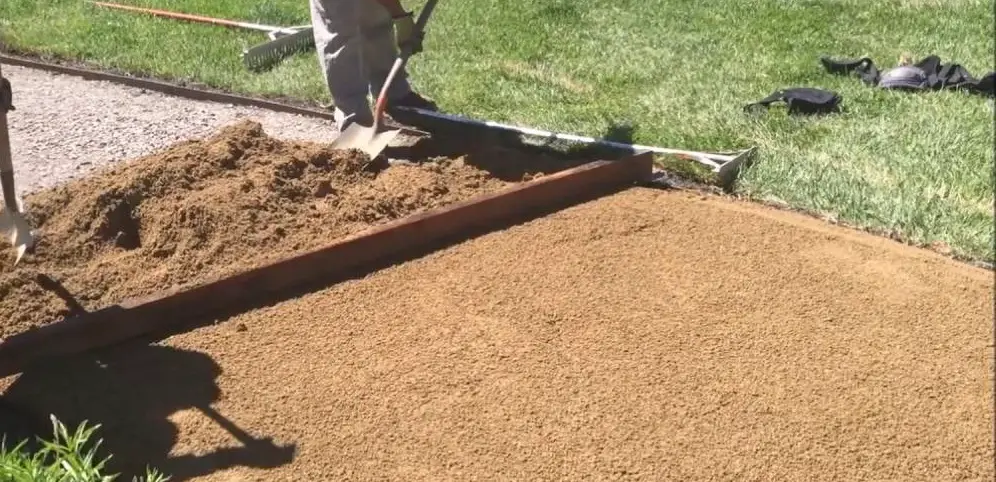


Considering DG and this was informative both pro and con. I have a relatively small yard and would like DG. Am in process of removing current rocks.
That’s great. Glad you found the article helpful. Cheers!
I live in the desert SouthWest and ripped out my grass this year in favor of desert landscaping with DG. Lately, the area around my plants have been collecting a white residue -which looks like salt. Is there a way to avoid this or remove it?
“doesn’t hurt to have a quick look at some of its disadvantages.”
should be advantages
Thanks for the heads up!
I bought a house that has mostly DG in the backyard. I hate it. It’s so easy to track in everywhere; on the concrete patio, then into the house. It sticks to your sandals or shoes. I have real hardwood floors, so now I have to spend quite a bit to have most of the DG removed and replaced with a true hardscape like pavers or concrete. I think DG is pretty in certain landscapes, but it’s not practical for the average home. It does not make good material to walk on. DG is crushed granite and granite is almost as hard as a diamond; it’ll scratch up your nice tile floors too, and then you are having to be very careful coming in and out of the house, and have to avoid walking on it. Having to be careful not to track in it makes it high maintenance. Sometimes designers use material for design sake, not thinking about its practicality, and everyone copies the designers. I’m removing it from my yard so I don’t have to tip toe around the yard anymore. It’s a real pain. If you use it, use it for design purposes away from the yard as plant border material, not to walk on.